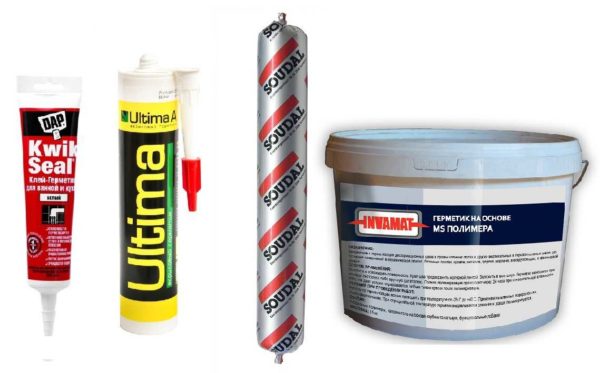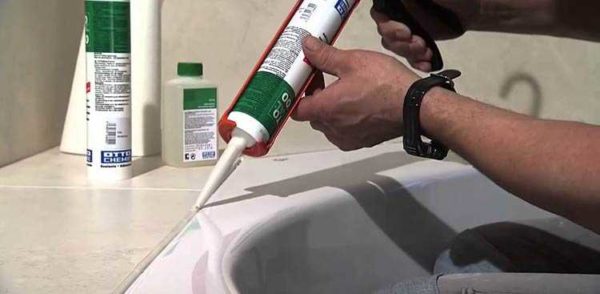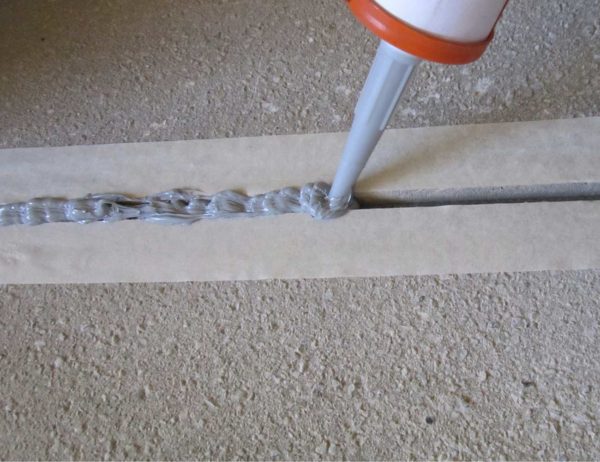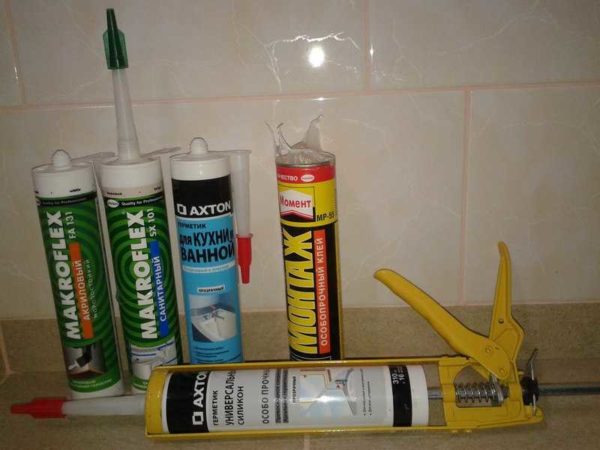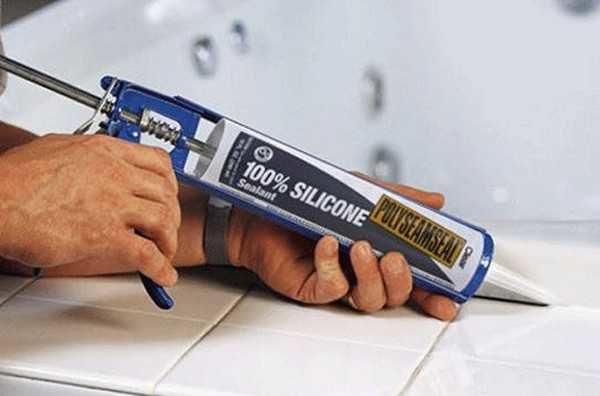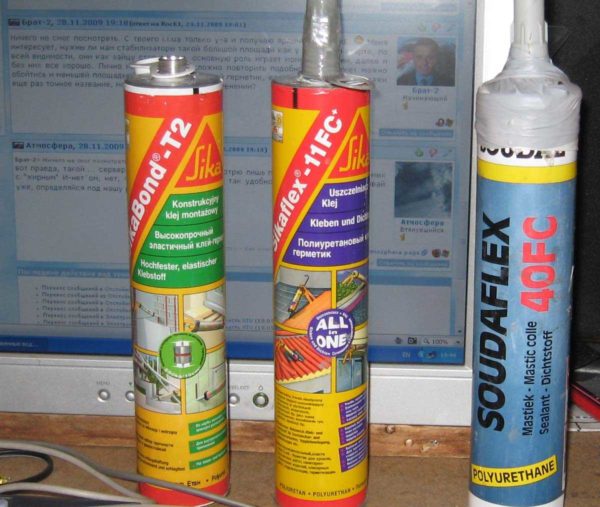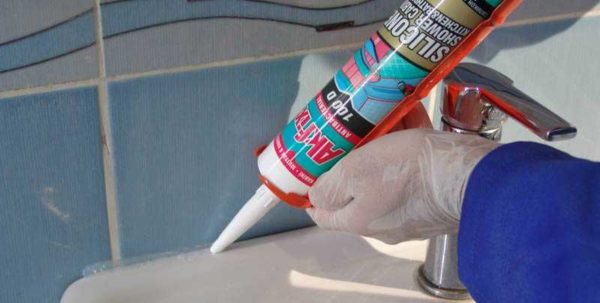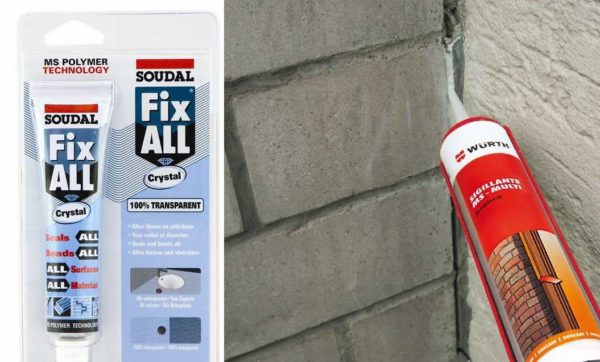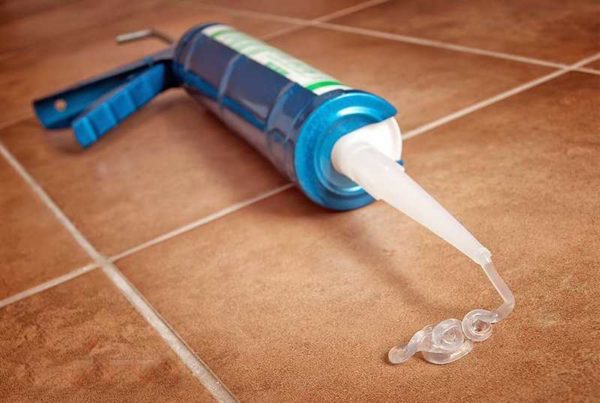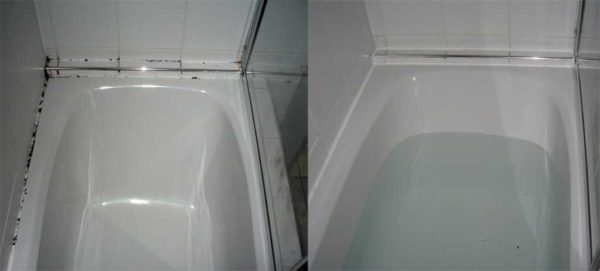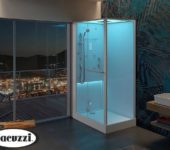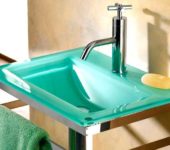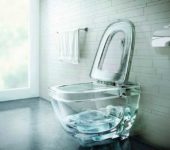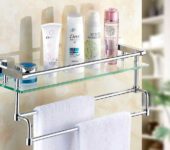Which sealant is best for the bathroom
When carrying out repairs in the bathroom, it becomes necessary to use sealing compounds. It is necessary to prevent water from entering the gap between the bathroom (shower) and the wall, between the sink and the wall. It may also be necessary to fill cracks in the wall material, tile joints, seal pipe joints, furniture edges, etc. For these purposes, a bathroom sealant is used. You can choose, but you need to know what the compositions are and how they differ from each other.
To begin with, it's worth talking more about the release form. There are several types of bathroom sealant in stores:
- In a regular tube, which comes with a cone-shaped cap. The mass of the composition is 60-100 grams. It is understood that sometimes a small amount of formulation is required. But squeezing out an even strip of sealant from such a tube will not work. We'll have to wipe, level, rub.
- Tubes for a construction gun. They have a larger volume - 280-320 ml, they can be large - with a volume of 500-600 ml. It is easier to work with them as it is easier to control the effort. It will also have to be corrected, but much less.
- Packing in an aluminum tube (sausage), buckets of various capacities and barrels. It is not used in private housing construction, these are professional volumes.
The most convenient option is in tubes for a construction gun. For independent work, this is the best choice.
The content of the article
Acrylic
These are the cheapest sealing compounds that at the same time have good technical characteristics:
- Does not contain hazardous and toxic components.
- Chemically neutral.
- Good adhesion to most surfaces (concrete, brick, plastic, glass, metal, wood and its derivatives MDF, Chipboard, plywood).
- Temperature range from -20 ° C to + 80 ° C (available with a wider and narrower range).
- Withstands long-term vibration with a small amplitude (used in mechanics and mechanical engineering when installing devices).
- After polymerization, the seam is inelastic, fracture begins at 10-12% elongation.
- Fast drying.
- The dried surface can be painted or varnished.
In general, good qualities, especially when you consider the low cost, as well as harmlessness. You can work with acrylic sealants without protective equipment, and the short time required for curing speeds up the work. Their disadvantage is shrinkage during drying. Because of this, when in contact with water, the seam begins to leak, so such a bathroom sealant is best used in places where water does not flow. Also, prior to application, for better adhesion, a surface primer (under acrylic) is required. In this case, you are more likely to get a leak-proof seam.
Application area
The main disadvantage of acrylic sealants is the stiffness of the resulting joint. Even with small extensions, it bursts. That is, it is not worth using it to protect the junction of a steel or acrylic bath (shower tray) with a wall. Under load, they change their size and so that the seam does not collapse, it must be elastic.
Perfect for filling voids and cracks in various building materials (brick, concrete, etc.), joining fixed or inactive joints (gaps between the jamb and a brick or concrete wall, sealing knocks in pipes, etc.). These compounds treat the unprotected edges of furniture that is installed in the bathroom, suitable for filling the junction of the sink with the wall.
Another unpleasant moment: in a humid environment, fungi and bacteria grow well on the surface of an ordinary acrylic sealant. This disadvantage is eliminated by the presence of antiseptic additives, but it is better not to use acrylic sealants for areas constantly in contact with water.
And one more thing: in the bathroom, acrylic quickly changes color - it begins to turn yellow. Therefore, you should not use white. Better colored (there are some) or transparent. Color changes are not so visible on them.
When choosing, it is worth remembering that acrylic sealants may or may not be waterproof. Acrylic bathroom sealant must be water resistant. Even in those areas where water cannot directly contact with it, but due to high humidity it can absorb moisture from the air.
Acrylic sealant brands
There are quite a few good brands. Only for the bathroom, it is imperative to look so that the composition is moisture resistant.
- Bison Acrylic. There are several different formulations: Super fast, drying in 15-30 minutes, Universal - can be used to seal wood.
- Bosny ACRYLIC SEALANT;
- Boxer;
- Dap Alex Plus. It is an acrylic latex compound with more elasticity and additives against fungi.
- KIM TEC Silacryl 121. Polyacrylate moisture resistant and elastic sealant. Can be used in areas of prolonged contact with water.
- Penosil. For filling joints and cracks that are not in direct contact with water.
There are many other brands and manufacturers. Many acrylic sealants have special additives that change their properties. If you are satisfied with their harmlessness, you can find a composition even for direct contact with water.
Silicone
Quite a popular type of sealing compounds. In composition, they can be acidic and neutral. Acidic ones are easier to manufacture, they are cheaper, but it is difficult to work with them indoors - they have a strong smell until they harden. The second negative point of acidic - when applied to a metal, it quickly oxidizes. Therefore, you should not use it to seal steel and cast iron baths. Neutral silicone sealants do not react with materials, therefore their field of application is wider. But the production technology is more complicated and they cost more.
Both acidic and neutral silicone sealants may or may not be waterproof. Only waterproof baths are suitable. They also come in one-component and two-component. For private use, one-component is mainly used, since they do not need to be mixed before use.
Properties and scope
Properties and applications of silicone sealants:
- They have good adhesive properties. They can be used to seal the joints of stone and plastic window sills, when installing sinks and other appliances in the countertop.
- It is used for sealing glass joints, non-porous building materials (metal, plastic, glass, wood, ceramics), adhesion of plasterboard to the ceiling, drain pipes.
- They are characterized by increased tolerance to high temperatures and can be used to seal joints around chimneys.
- Resistant to water, can be used to seal the junction of bathrooms and showers, sinks and other plumbing fixtures.
The main advantage of silicone sealants is that after polymerization, the seam remains sufficiently elastic. It does not crack and can be used to seal the junction of an acrylic or steel bathtub with a wall. The disadvantage is susceptibility to the appearance and reproduction of the fungus. It is solved by adding antiseptic additives. To prevent the development of mold and mildew, it is best to use a silicone sealant for the aquarium or special plumbing. Both of these types have antibacterial properties.
Brands and prices
Silicone bath sealant is popular today and in any store there is a pretty decent assortment.
| Name | Colour | Special properties | Surface skin formation | Release form and volume | Price |
|---|---|---|---|---|---|
| BAU MASTER UNIVERSAL | white | acid | 15-25 minutes | Tube for pistol (290 ml) | 105 rbl |
| Bison Silicone Versatile | white, colorless | acidic, resistant even to sea water | 15 minutes | Tube for pistol (290 ml) | 205 rbl |
| KIM TEC Silicon 101E | white, transparent, black, gray | acidic, contains antibacterial additives | 25 minutes | Tube for pistol (310 ml) | 130-160 rub |
| Somafix universal silicone | white, colorless, black, brown, metallic | acid | 25 minutes | Tube for pistol (310 ml) | 110-130 rub |
| Somafix construction | white, colorless | neutral, does not turn yellow | 25 minutes | Tube for pistol (310 ml) | 180 rbl |
| Soudal Silicone U universal | white, colorless, brown, black, | neutral | 7 minutes | Tube for pistol (300 ml) | 175 rbl |
| WORKMAN Silicone Universal | colorless | acid | 15 minutes | Tube for pistol (300 ml) | 250 rbl |
| RAVAK Professional | neutral, anti-fungal | 25 minutes | Tube for pistol (310 ml) | 635 rbl | |
| Ottoseal s100 sanitary | 16 colors | acid | 25 minutes | Tube for pistol (310 ml) | 530 rbl |
| Lugato Wie Gummi Bad-Silicon | 16 colors | neutral with bactericidal additives | 15 minutes | Tube for pistol (310 ml) | 650 rbl |
| Tytan silicone sanitary, UPG, Euro-Line | colorless, white | acidic with bactericidal additives | 15-25 minutes | Tube for pistol (310 ml) | 150-250 rub |
| Ceresit CS | colorless, white | acidic / neutral | 15-35 minutes | Tube for pistol (310 ml) | 150-190 rub |
As you can see, there is a very wide variation in prices. Expensive sealants (Ravak, Ottoseal. Lugato) - made in Germany, Denmark, Czech Republic. According to reviews, they are of excellent quality - they have been used for several years without changes, the fungus does not multiply on them. They are presented in the widest range of colors.
Inexpensive Ceresit, Tytan, Soudal serve well. These manufacturers have a wide range of both acidic and neutral silicone sealants. There are also other types (acrylic, polyurethane). There are also good reviews on them for use as a sealant for a bathroom - a joint with a wall.
Polyurethane
Polyurethane sealants are good for outdoor use. They are not afraid of changes in temperature and humidity, they tolerate ultraviolet light well. They can work on open or closed, but not heated balconies and loggias. Also, their properties are in demand in wet areas - bathroom, toilet and kitchen. The main advantage is that they have a very good adhesive ability, for which they also call glue-sealant.
Properties and scope
Polyurethane based sealants can be used outdoors and can be applied at sub-zero temperatures (down to -10 ° C). And this is their main difference from others. They also have the following qualities:
- Elasticity after drying.
- Water resistance.
- No shrinkage during drying (no deformation and cracks in the seam, it remains sealed).
- Adheres well to brick, concrete, stone, glass, metals, wood, etc.).
- Many formulations may stain after drying.
There are also disadvantages. The first is low adhesion to plastics, which results in low joint strength. The second - cannot be used in areas of high temperatures (heating above + 120 ° C is prohibited). The third - should be applied to dry surfaces (humidity not higher than 10%). When applying to damp materials, a preliminary primer is required.
Low adhesion to plastics imposes restrictions on the use of polyurethane sealants in the bathroom. They are good for sealing the junction of a steel or cast iron bathtub with a wall, porcelain or glass sinks. But foracrylic bath installations or a shower cabin, they should not be used - the seams may leak.
Manufacturers, brands, prices
Polyurethane bathroom sealer is the best choice over acrylic. It remains elastic and does not crack. When compared with silicones, it is difficult to say which is better.The advantage of silicones is that they “stick” well even to plastics, and polyurethane compounds are odorless.
| Name | Colors | Special properties | Skin formation | Release form and volume | Price |
|---|---|---|---|---|---|
| BOSTIK PU 2638 | white, gray, black, brown | high adhesive power | 45 minutes | Tube for pistol 300 ml | 230 rbl |
| POLYFLEX-LM low modulus | White gray | UV and water resistant, do not apply to glass | 15 minutes | Tube for pistol 310 ml | 280 rbl |
| POLYURETHANE 50 FC | white | fast drying, suitable for bonding plastic, corrosion-resistant steel | 10 min | Tube for pistol 310 ml | 240 rbl |
| MAKROFLEX PA124 | white | resistant to water, weak acid solutions | 25 minutes | Tube for pistol 300 ml | 280 rbl |
| SOUDAFLEX 40 FC | white, gray, black | endures and dampens vibration | 15 minutes | Tube for pistol 300 ml | 290 rbl |
This type of sealing compounds is more related to general construction. Many compounds are ideal for filling interpanel joints in multi-storey buildings and for other similar work. Bathroom sealant is one use case.
MS polymer sealants
A newly emerged type of sealant that is rapidly gaining popularity due to its excellent properties. They combine the qualities of silicones and polyurethanes, reliably protecting against leakage, forming elastic and reliable connections.
Properties and scope
The main advantage of sealants based on MS polymers is that in addition to the properties of the sealant, they still have a high adhesive ability, therefore, their polymers are also called adhesive sealant. They have the following properties:
- Excellent adhesion to all building materials without the need for primers.
- Solvent free, safe and virtually odorless.
- They dry quickly and harden even at subzero temperatures (only slower).
- When dry they do not harden, they remain elastic (elasticity range 25%).
- After drying, you can paint.
- They do not crack or change color under the influence of the sun.
- Waterproof, can be used in fresh and salt water.
- When applied, they do not spread, on vertical and horizontal, inclined surfaces, a neat seam is easily formed.
Excellent properties. There are also disadvantages. The first is a high price, but it is justified, since the seam does not crack and does not leak for a long time. The second - after a while, the surface of the white sealant may turn yellow. This does not affect the quality of the seam, but it looks ugly. You can remove yellowness by wiping the seam with refined gasoline. The third minus - after hardening, the composition is removed only mechanically. No solvents act on it.
Manufacturers and prices
Almost every major manufacturer has MS sealants, and they are also available with various additives that give special characteristics, so you can choose exactly according to the situation and for a specific type of work.
| Name | Colour | Special properties | Skin formation | Release form | Price |
|---|---|---|---|---|---|
| Bisin MS Polymer (adhesive sealant) | white / transparent | Glass, mirrors, plastics, bricks, natural stone, concrete, wood, iron and many other metals. | 15 min at + 20 ° C | Tube for pistol (280 ml) | 490-600 rub |
| BOSTIK MS 2750 | White black | Metal, wood, glass, expanded polystyrene, etc. | 30 min at + 20 ° C | Tube for pistol (280 ml) | 400-450 rub |
| BOSTIK SuperFix | White gray | Suitable for underwater, swimming pools and rooms with high humidity | about 15 minutes | Tube for pistol (280 ml) | 400-550 rub |
| TECFIX MS 441 | transparent | Resistant to sea water, chlorine, mold and fungi | 10 min at + 23 ° C | Aluminum film sleeve (400 ml) | 670-980 rub |
| 1000 USOS | white, transparent, gray, blue, green, tiles, black, brown | For bathrooms and kitchens with anti-mold action | 15 min at + 20 ° C | Tube for pistol (280 ml) | 340 rbl |
| SOUDALSEAL High Tack | White black | For sanitary rooms and kitchens - resists the formation of fungus | 10 min at + 20 ° C | Tube for pistol (280 ml) | 400 rbl |
| SOUDASEAL 240 FC | White, black, gray, brown | For sanitary rooms and kitchens, fast curing | 10 min at + 20 ° C | Tube for pistol (280 ml) | 370 rbl |
| SOUDASEAL FIX ALL High Tack | White black | For sanitary facilities, super strong initial hold | 10 min at + 20 ° C | Tube for pistol (280 ml) | 460 rbl |
Despite the fact that this type of sealant has appeared recently, the range is solid, since the combination of high adhesive ability and sealant properties is very convenient and the product is in demand.
The main advantage of MS sealants is elasticity after drying, tolerance of prolonged direct contact with water, and resistance to the growth of fungi and bacteria. Therefore, this type of sealant is used to seal the junction of a bathroom or shower stall with a wall. In the case of a shower cabin, it is also good because it does not slip when applied vertically.
Another positive point - most of the compositions have a pasty consistency, which lies flat, does not bubble. After application to the initial curing (skin formation), the applied sealant can be easily smoothed into the desired shape.
Which bathroom sealant is better
It is necessary to choose the type of sealant for specific tasks. Then you can select the optimal properties. For example, to seal the junction of a bath or shower stall with a wall, the best choice is a sealant based on MS polymer. Not bad - silicone and polyurethane. But they must have antibacterial additives.
Neutral silicone sealant is excellent for bonding mirrors. Any silicone (or acidic) is coated with cuts of countertops, edges and cuts of furniture that is installed in the bathroom or in the kitchen.
If you need to glue the fallen off tiles in the bathroom, a polyurethane compound or with MC polymers will do. Due to their high adhesive power, they immediately fix the product in place. Since the compositions do not shrink when dry, there is also no risk of damaging the tiles.
If you need a bathroom sealant to seal pipe joints, you need to look at the material from which they are made. For pipes made of steel and cast iron, neutral silicone, polyurethane and MS polymer are suitable. For plastic and metal-plastic polyurethane, it is better not to use, and any silicone compounds are suitable.
At registration bathroom in a wooden house walls are usually sheathed with moisture resistant gypsum board. But since the house is constantly "playing" in height, there is a gap between the ceiling and the gypsum board - to compensate for these changes. To prevent moisture from getting there, it must be filled with something, but so that the seam remains elastic. Silicone and MS polymer formulations can also be used for these purposes.
To solve the problem with blackening of the seams, it is necessary to choose formulations with antibacterial additives. There are also special sanitary sealants available. They are so named precisely because of the presence of additives against fungi and mold. Aquarium sealants are also suitable for this purpose. They have excellent adhesion to most materials and never blacken.
As you can see, for each type of work, the best bathroom sealant is different, but the most versatile is for MS polymers.

